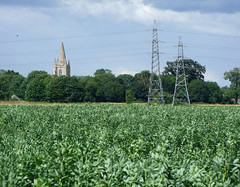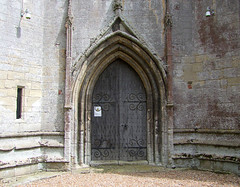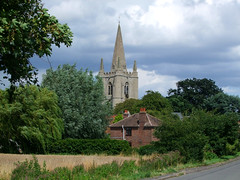| |
|
All
Saints, Tilney All Saints
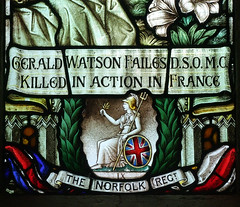 |
|
West Norfolk is flat, but
without the haunting bleakness of neighbouring
Lincolnshire and Cambridgeshire. To be honest, it
is all a bit too suburban to be mysterious, and
where there aren't bungalows there is an
agri-industrial busy feeling. Tilney All Saints
is unusual because it is actually rather a pretty
village. All Saints
is another very big church with an absolutely
massive tower, with as much in common with
Lincolnshire churches as it has with anywhere
else in East Anglia. The building is delightfully
sleepy; ramshackle, and looking as if it would
rather not be bothered too much. It reminded me a
bit of a cat I used to have. The spire is like
the one at nearby Walsoken, but this is a move
into Decorated, and is full of confidence. Oddly,
Pevsner refers to this as one of the C12-C13
Fenland churches with very long naves,built
when the land was reclaimed from the sea.
While it is certainly true that evidence survives
of Roman sea defences to the north of here, and
there is also evidence of late Saxon attempts to
prevent tidal incursions locally on a small
scale, it is extremely unlikely that the
technology existed in early medieval England to
reclaim land from the sea on such a large scale.
|
Pevsner is probably confusing the
Norfolk marshland with the Cambridgeshire fens, which
were successfully drained by the Dutch half a millennium
later. Certainly, this area was once under water; but it
is the rivers themselves that have turned it to land, by
bringing silt down out of Bedfordshire, Northamptonshire
and Cambridgeshire, and building it up into banks at the
river mouths. The estuary has slowly moved northwards,
but this happened long before the 12th century. We may
assume that this land was more vulnerable then to
inundation than it is today, but that's all.
The clerestoried and aisled nave speak of a familiar East
Anglian Perpendicular. The ivy on the north side is
covering windows and working its way through the north
door. You enter through the vestry, which is at the west
end of the south aisle and originally had two stories,
not dissimilar to Terrington St John. I wondered if it
had been a Priest's residence, although later I was told
that it is not medieval at all, and was a school room.
You step into a glorious wide open interior, full of
light. It is similarly ramshackle to the outside, laid
out under a fine angel hammer-beam roof. Gorgeous Norman
arcades reveal the true age of this place (again, as at
Walsoken) and stretch away to the east. The capitals
increase in elaboration towards the chancel, and then,
just before they disappear, they jump a century and
become Early English pointed arches. Turning back, you
see that they are matched by the breathtaking tower arch
- this is very much a church where the presiding minister
gets a good view.
There is a very curious font. At first sight it appears
early 17th Century, and this is the date assigned it in
Pevsner and elsewhere. Its panels include two scriptural
quotations in Latin, and two in English from the Geneva
Bible (one reads see, here is water: what doeth let
me to be baptised). One of the other panels features
a Tudor rose, Unless the font was commissioned in the
eight years between James I coming to the throne in 1603
and the Authorised Version of the Bible being published
in 1611, it may well actually be a late 16th Century
font, an unusual thing.
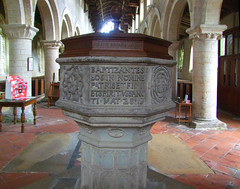   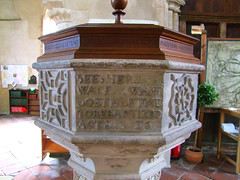
Slightly later is the screen, dated
1618 and turned and balustered as if for a staircase in a
country house. The chancel itself is full of the sobriety
of the early 17th century, quite at odds with the
glorious arcades behind. A war memorial window features
St George and St Martin, and there is a good Queen Anne
royal arms. An old font sits on the floor in the north
aisle, along with some early medieval grave slabs.
Tilney All Saints is probably less well-known than its
near neighbours at Walpole, Walsoken and Terrington; but
I thought it was lovely, a subtle and gently beautiful
place at peace with its parish.
Simon Knott, September 2016
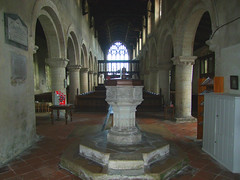  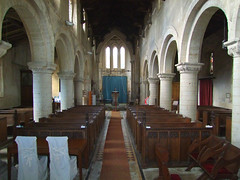
 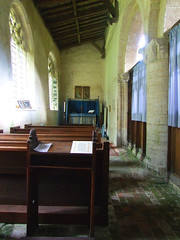 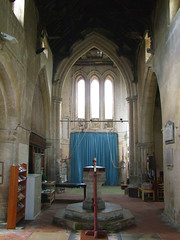 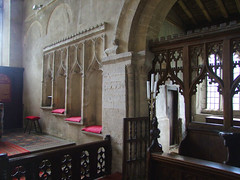
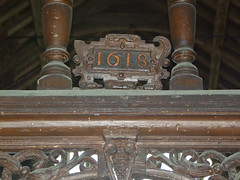  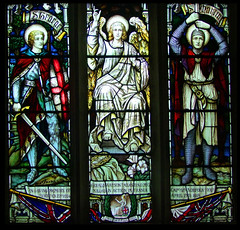 
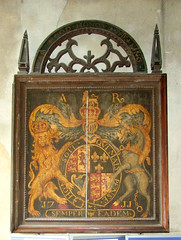 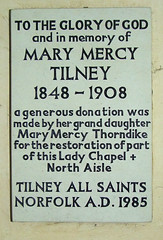 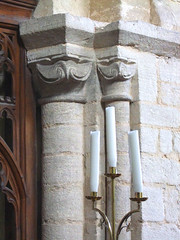 

|
|
|

